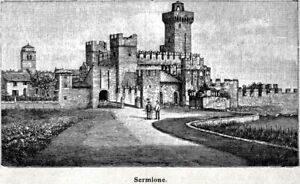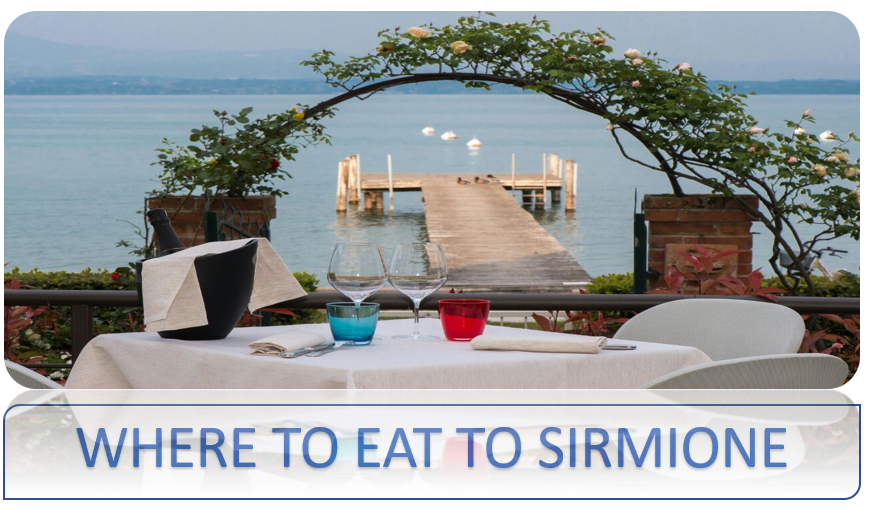HISTORY OF SIRMIONE
Certainly inhabited from the remotest ages, the Romanesque “Sirmio” was just described by the poet Catullo, who lived here once a time. During the High Middle Ages a castle was built and so Sirmione became the important military headquarters, which could be defended till 1500. The Longobards founded “fines sermionensis” a long frontier line, beginning from Lake Garda up to Mantova. Then the German sovereign “Karl der Grosse” captured the monastery of the Benedicitines “San Martino di Tours“, in 1197 the peninsola was reigned by the Commune of Verona, and only a few years later – in 1200 – it was just occupied by the troops of the King Friedrich II, who detained the fish rights of that zone. In those days many “Catari” = hermits settled down in the surroundings of Sirmione, having the benefit of its well known, mild climate. But in 1278, commanded by Mastino I, the town passed under the rule of the Scaligery, who sentenced to death all those hermits – about 120 – in Arena of Verona. The Republic of Venice succeeded the Scaligery and in 1405 Sirmione took part of the “Serenissima”.

ARTS Discover Sirmione
For coming in, you have to take an access road, connecting the peninsola with the mainland. A big portal of the 13th. century is placed at the entrance and a water channel is still surrounding the historical centre, always “besieged” by a lots of tourist and antique fisher boats, remembering the traditional craft of Sirmione: FISHING. On the right side rises the powerful Scaligero castle, giving the town a Medieval aspect. It was built by Cangrande della Scala in the 14th. century with 3 towers in the corners, a main tower, 37m high, and an entrance tower, called “Torrione”. From the Keep, called “Mastio” there are wonderful panoramic views and from the inside staircases you can reach the patrol communication trenches. The castle keeps inside Romanesque and Medieval tombs and a water- archaeological museum. Directly behind the entrance portal, on the left side, there is a little church, “Sant’Anna della Rocca“, a temple of the 14th. century, built for the soldiers of the castle, coming here for praying. Inside it keeps wonderful frescoes of the 15th. century and wall decorations of the 16th. century.
The Parish “Santa Maria Maggiore“, of the 15th. century has a columned portico. Outside the columns of the main-nave belong to the roman period, (the 4th. century) edified during the supremacy of Guiliano l’Apostata. Inside it keeps beautiful frescoes (13th-14th.century) and a precious wood statue of Our Lady. The altar and the organ in finely worked wood and inlays derive from the 17th. century. Its bell tower is an original Scaligery tower. The church “S. Pietro in Mavinas” rises on the top of the peninsola on ruins of an ancient pagan temple. In 1000 it was completely restored and a bell tower was built. In the 13th. century it underwent several modifications. Inside you can admire wonderful coloured frescoes on the wall and in the apses. During the Imperialism many palaces and villas were rising on the coast of Lake Garda, the most famous of all is the palace, to find on the top of the peninsula. Once a time, in 1483, the Venezian journalist Marin Sanudo called it “Grotte di Catullo” = Catullo Craves.
The ruins date back to the first century, when that large unique complex was inserted downright in the rock. Its rectangular construction is 167 m long and 105 m large and it has 2 great entrances. In the South West part of the villa, they placed the thermal part, the Roman Thermae. Unfortunately a great fire in the 15th. century has destroyed great parts of the palace. During archaeological excavations they found a “Criptoporticus” divided by a row of pillars, the “piscine”, four flights of stairs led to the large basin, called “Tepidarium”, some underground floors and least a large hall with windows, the “Trifora del Paradiso”. Many rooms and halls have coloured mosaic floors, fragments of wonderful frescoes on the walls, and several Bronze objects were found. Near the entrance there is a little antiquarium, where the most interesting ruins are kept. From the “Grotte di Catullo“, following the road “Via Catullo“, we reach “Villa Cortine“, testimony of the eternal elegant tourism of this charming peninsula. This palace was built in neoclassic style, in order of the baron Kurt von Koeseritz. It has a wonderful entrance- portal and a triangle loggia, a wonderful park with fountains, the most famous ones are the fountain “Nettuno” and the fountain “Monte Baldo“. Today Villa Cortine has become an elegant hotel.
Nearby the park of “Villa Cortine”, you can find the public gardens, dedicated to the famous singer “Maria Callas“, very often guest in Sirmione in 1950. Other personalities describing the beauty of “bello sirmio” were Giovanni Prati, Giosuè Carducci, Ezra Pound and James Joyce. Continuing our sightseeing walk, we arrive at the square “Piazza don Piatti“, where is situated another “Roman Thermae”, with active thermal fountains, coming up 18 m from the depth of the earth, with a heat of 69°C. Since the 16th. century these fountains are active, but only in 1889 they were discovered for medical use. The water is rich of sulphur, sodium and choir, today it has become an important thermal complex, where you can make inhalations and special courses of treatment against arthritis, all kinds of neurological disturbs, deafness and bronchitis. A several part of the complex is exclusively used for the “beauty”.
The whole thermal complex of Sirmione, today directed by the cooperative “Società Terme e Grandi Alberghi”, is divided in two parts, the ancient one, called “Catullo Caves”, nearby the historical centre, used frequently during summertime, from March till September. The second part, situated in the district Colombare, is called “Virgilio” connected to three hotels with integrated courses of treatment.
ATTRACTIONS
Sirmione, well known for its elevated tourism, offers many attractions during summertime. On the sea promenade they daily organize fashion shows or music-concerts.
But the real miracle of its beauty is to find at the beginning or the ending of the season, when the splendour of its landscapes are reflecting the shiny colours of the sun rays.
The town is attraction by itself, with all its charming and its traditions, for example, have a look at the wonderful fruit stand, nearby the entrance portal, selling pieces of melons or pineapples, lemons and coconuts!
Sirmione is the uncrowned Queen of Italian Flair on Lake Garda, a wide wonderful natural park, run along by alleys and paths among a plentiful vegetation of cypress trees, magnolias and olive trees, mixed with lot of original shops and boutiques.
Discover Sirmione
